Text
Woman in Hiding

Ida Lupino didn’t want to make Michael Gordon’s WOMAN IN HIDING (1950, Criterion Channel), and though it’s far from monkey dump, it’s easy to understand why. One of the toughest women on screen was being asked to play a near total victim, and she must have known the casting was wrong. At least the picture gave her a new husband and a chance to learn more about directing from Gordon before she embarked on her second film as director.
The film opens with Lupino’s car plunging into a river. As her grieving husband (Stephen McNally) watches the police drag the river, her voiceover says, “That’s my body they’re looking for.” That leads into an extended flashback revealing that McNally had courted the wealthy Lupino after her father’s death at the factory he owned and McNally ran. On her honeymoon, she’s confronted with McNally’s mistress (Peggy Dow, also cast against type) who reveals that her ex- and Lupino’s current had killed her father. Lupino takes off in the car only to learn the breaks have been cut. Back in the present, she decides to let everyone think she’s dead (which makes about as much sense as McNally’s plot to murder her) and takes off to find Dow, whose testimony can help her convince the police to arrest McNally. On the road, she meets Howard Duff, who starts following her around out of concern or lust or maybe greed (there’s a reward for finding her). So, yes, the plot is a lot of nonsense, though it’s interesting in that it’s clearly based on patriarchal power; nobody will believe a woman shouting murder.
Lupino is fine when she has lines, and the scenes of her burgeoning relationship with Duff are quite strong (they fell in love on the production and married a year later). But when she has to react in silent horror, it’s all wrong. She falls back on tired tricks like clutching her pearls and whipping her head around, and it’s hard to watch McNally manhandle an actress who in other roles would have smacked the snot out of him. Fortunately, Gordon, whose promising career would soon be cut short by the blacklist, has a great visual sense. He frames some terrific shots and the finale, in a deserted factory at night is a shadowy delight, shot by William H. Daniels. Joe Besser is a conventioneer, Peggy Castle a waitress and Tony Curtis the voice of a bus driver.
#film noir#suspense#ida lupino#howard duff#stephen mcnally#tony curtis#peggy dow#joe besser#peggy castle#michael gordon
0 notes
Text




The men of SEE NO EVIL 2 (2014) clockwise from top left-Greyston Holt, Lee Majdoub, Kaj-Erik Eriksen and Michael Eklund
0 notes
Text
See No Evil 2

To say Jen and Sylvia Soska’s SEE NO EVIL 2 (2014, Tubi, Plex, Roku Channel) is better than the original SEE NO EVIL (2006) should not be taken to oversell it. It would have been hard to have made a worse movie since Ed Wood, Jr. and Phil Tucker are long dead. WWE Films doesn’t get a lot of points for quality, but at least moving the production from the original’s Australia to Canada allowed them to hire the Soska Sisters to direct and allowed them to cast two talented scream queens, Danielle Harris and Katharine Isabelle. Had they really been smart, the WWE would have hired the Soskas to write, too, but they apparently already had a script ready for them to attempt to salvage. The Soska Sisters know how to use the camera and editing to generate suspense, and they get decent work out of most of the cast. They even help wrestler Glenn ‘Kane’ Jacobs (You didn’t think the WWE produced films for love of the art, did you?) deliver something resembling a performance.
The first act, which sets up the main characters, works best. Med-school dropout Amy (Harris) works at the city morgue with mortician Seth (Kaj-Erik Eriksen). They have crushes on each other but are reluctant to act, despite encouragement from their boss (Michael Eklund), When they learn they’re about to receive the dead bodies from the previous film — with flashbacks showing most of their death scenes and suggesting the morgue is in a district with much better lighting and color values — Amy takes a raincheck on her birthday party to help out. So, her friends bring the party to the morgue just in time for the killer (Kane) to pop back to life. At that point, the film starts falling apart. There are endless scenes of people running around in the dark and bumping into Kane so he can kill them. At least early on Isabelle pops out of the shadows every now and then, but since she’s not one of the main lovers, you know she’s not long for this film, which is a pity.
Harris and Eriksen are charming as the hesitant lovers, and Isabelle makes the most of her short part. She’s playing a young woman so obsessed with serial killers she gets turned on being in the same room with Kane’s supposedly dead body, and she has the skill and taste to hit her comic beats without working them to death. The rest of the cast is okay too, and it’s a mercy that nobody from the original film except Kane shows up. But ultimately, good camerawork, editing and acting can’t defeat a wretched script that devolves into nonsense for an ending meant to set up a franchise that, praise the goddess, never happened.
#horror films#pro wrestling#kane#soska sisters#katharine isabelle#danielle harris#kaj-erik eriksen#michael eklund
1 note
·
View note
Text
Lightning Strikes Twice
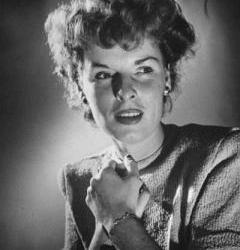
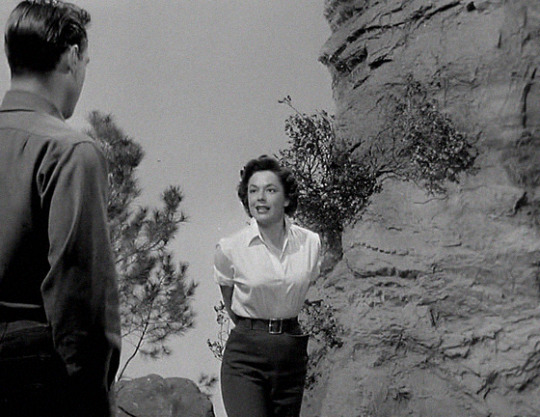
With the exception of RUBY GENTRY (1952), King Vidor’s melodramas are mad messes. Though it has some good moments — particularly in the performances of Mercedes McCambridge, Zachary Scott and Kathryn Givney — his LIGHTNING STRIKES TWICE (1951, Criterion Channel, TCM, Plex) can’t seem to make up its mind what it is, so it ends up a Southwestern Gothic romantic film noir. Actress Ruth Roman travels to Texas for a rest cure after growing ill playing Desdemona on tour. Yes, that’s foreshadowing. She becomes fascinated with recently released accused wife-killer Richard Todd. For a while she wants to find out who really did the deed, but she keeps getting sidetracked. That’s not so bad when she has to deal with romantically frustrated McCambridge (was she in love with Todd or his late wife; her lips tell me hetero, but there’s lesbian in her eyes), dissolute playboy Scott (every state has one) and female power broker Givney. But she keeps having run ins with Todd, who’s so moody he makes Heathcliff seem like Peewee Herman.
For much of the film Vidor seems to have directed most of the affectation out of Roman’s work, and she’s engagingly natural. But then it’s time to wrap the story up, so she has to decide Todd’s a killer, leading to an orgy of heavy breathing and nostril flaring. Of course, even at her best, she’s no match for McCambridge, whose acting is so fresh and original nobody else stands a chance. She manages to pull her character’s conflicting impulses together (she’d have made a great Hedda Gabler) and comes out with a performance even when the melodrama ascends to its most delirious levels.
Faced with a meandering, sometimes ludicrous script (by Lenore Coffee, from a novel by Margaret Echard), Vidor seems to have devoted most of his energy to the locations. At times, the Mojave Desert and various other locations (including the director’s own ranch) seem more compelling than the leading characters. The desert becomes a site of passion, driving people mad with desire. Vidor also does a good job contrasting the different architectural styles — the sleek modern ranch where Givney and her husband reign, McCambridge’s ramshackle dude ranch, Todd’s Spanish style house and the bleak small town plopped in the middle of all that dust and sand. It’s a pity the sets are so poorly supported by the script.
0 notes
Text
Ghostwatch


Since some sources have pointed to writer Stephen Volk’s GHOSTWATCH (1992, Shudder, On Demand at Prime and YouTube) as the inspiration for LATE NIGHT WITH THE DEVIL, I felt compelled to watch it to see for myself. There are clear parallels, particularly in that they share similar dramatic arcs. But they both start from a different hook and diverge in a lot of details. That’s not to deny any influence but simply to put it into perspective. Oddly, GHOSTWATCH is classified as a mockumentary rather than a found-footage film. I suppose what keeps it from being found footage is that it’s purportedly a live telecast. It’s also formatted much more logically than most found footage films.
A BBC News show with actual BBC personalities (presenter Michael Parkinson and married reporters Sarah Greene and Mike Smith) is presenting a live Halloween broadcast about a haunted house, with Greene on the scene with the single mother and her two young daughters living there, Smith fielding phone calls from viewers with their own paranormal experiences to share and Parkinson anchoring the show from the studio alongside a paranormal investigator (Gillian Bevan) who’s been studying the case. Things start out simply, with the family sharing their stories while neighbors comment on the effect the haunting has had on their district. But then little things start happening — strange noises, a wet spot on the floor, falling pictures — until all hell breaks loose.
The program is remarkably effective (so much so some viewers believed it was real, despite disclaimers, and even complained of suffering from PTSD). Using real broadcast personalities helps greatly with verisimilitude. They don’t seem to be acting, even when Smith becomes genuinely concerned for his wife’s safety. And Bevan has captured the inflections of real people not accustomed to public speaking. Her voice keeps trailing off. There’s also a fascinating treatment of gender as Greene naturally falls into a motherly role with the two young girls, their mother (Brid Brennan) fights to protect her daughters and Parkinson attempts to exercise patriarchal authority over all concerned, particularly Bevan, whom he keeps trying to bully into giving concrete answers about her ever-evolving research. Her repeated, “I don’t know” becomes almost a mantra for the show. Volk also gets credit for cleverly constructing the script as if it were a mystery, with neighbors and callers offering pieces of the puzzle to explain what the source of the haunting might be. The result is one of the creepiest 90 minutes of TV you’re likely to see.
7 notes
·
View notes
Text
The Shining Hour
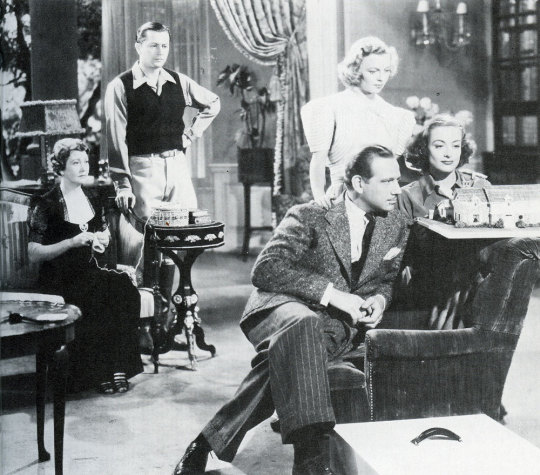
She enters dancing. Though she’s not as graceful as the best dancers, she has great extension, and her spirit is so light she seems to be floating on air. If you’ve only seen Joan Crawford in her later films, seeing her in her prime in Frank Borzage’s THE SHINING HOUR (1938, TCM, Plex) can be a surprise. It’s a pity the rest of the film doesn’t carry out the buoyancy of her first appearance. The courtship scene with Melvyn Douglas that follows keeps the ball in the air. He's an expert romantic comic, and Crawford rises to his level. She even wrote some autobiographical lines that mirror her own upbringing in poverty. When he takes her to his family’s Wisconsin estate, the stage is set for a brittle comedy about the clash between city folk and country folk, redolent of early American bucolic comedies. There are even scenes that suggest how good it could be — a contretemps over tea, and a moment in which Crawford dances to the radio as her sister-in-law (Fay Bainter) looks on disapprovingly. But no, the material instead descends into turgid melodrama as Crawford finds herself drawn to her married brother-in-law (Robert Young), as if any sane woman would give up Douglas for Young or any sane man, for that matter, would give up Young’s on-screen wife, Margaret Sullivan, for Crawford.
It's all very frustrating, as there’s a good story trapped inside the soap. Crawford’s main adversary is her sister-in-law, and Bainter is another surprise. Her film roles were largely benevolent, but she had also made a hit on stage as the wife in DODSWORTH, and she draws on that bile here. Her Hannah is tight and judgmental. She knits socks with yarn and needles so tight it’s amazing she can force a single stitch out. Until the script does her dirt at the end, she’s a marvel of subtextual malice.
But the script does almost everyone dirt. Crawford is light and charming until she has to start playing forbidden passion for Young. Then she turns to heavy emoting marred by her inability to play against the meanings of her lines. And Young is just hopeless. He seems physically uncomfortable trying to make love to her. Only two performers survive all this. Sullavan is so lustrous she makes her longsuffering character seem noble and even intelligent. She’s got the most Borzagian character in the film, and he lavishes beautiful closeups on her as her voice quivers and she fights back tears that just make her eyes glow even more. Even better is Hattie McDaniel as Crawford’s maid, Belvedere. She’s the only character who gets to play fish-out-of-water comedy throughout (no hidden passions for her!), and though she’s missing for a lot of the final act, she gets the last word in a way that cuts through the foolishness of all these idiotic WASPS so repressed they never even get around to explaining what the title means. While they’re on screen, the hour doesn’t shine; it just sputters.
#frank borzage#joan crawford#melvyn douglas#robert young#margaret sullavan#fay bainter#hattie mcdaniel
0 notes
Text
Late Night With the Devil

Like a TWILIGHT ZONE episode, Colin and Cameron Cairnes’ LATE NIGHT WITH THE DEVIL (2024, Shudder) is built around a protagonist’s simple goal or flaw that leads to disaster. In this case, 1970s talk show host Jack Delroy (David Dastmalchian) wants to beat Johnny Carson in the ratings. So, he books a Halloween episode during sweeps with a psychic (Fayssal Bazzi), a professional skeptic (Ian Bliss) and a parapsychologist (Laura Gordon) who claims to have spoken to “Mr. Wiggles,” the demon possessing a young girl (Ingrid Torelli) who survived a satanic cult’s suicide. Things start going wrong when Bazzi departs from his usual patter based on prior knowledge about audience members and connects with a spirit who may be Dastmalchian’s recently deceased wife. When the host convinces Gordon to call up Mr. Wiggles, things get even worse.
The Cairnes Brothers have paced their film quite well. There’s enough humor to maintain interest and preliminary scares to build tension. Their re-creation of a 1970s syndicated talk-show is dead on, from design to the ineffectual, toadying announcer and the band falling out of their chairs over the host’s jokes. And Dastmalchian makes Delroy such a believable, complicated character, you want to watch just to see how he’s going to deal with the situation. His response when Torelli mentions his wife’s death is a virtual rhapsody of emotions played in just a few seconds.
The film is set up as an episode of a documentary series showing the recently rediscovered master tape for the program, so it’s clearly in the found-footage subgenre. It even opens with an eight-minute documentary detailing the talk show’s earlier years and its fading ratings after Delroy’s wife died. But like many found-footage films, it sacrifices some logic toward the end. The show is shot in the standard three-camera format, with an unseen director in the control room cutting among the three feeds. But the cutting continues as the show dissolves into chaos and fantasy, which leads you to wonder why anybody stayed in the booth when their lives were in danger. Since this is set up as a documentary, it’s also strange that there’s no wrap-up. The last bit of tape from the program is the last thing we see. Perhaps the filmmakers wanted us to imagine what the results of all this were, but I felt as if I were left hanging. And that choice also clearly violates the rules they set up at the beginning. It’s a miscue in a film that gets a lot of other things right.
2 notes
·
View notes
Text
Stage Fright

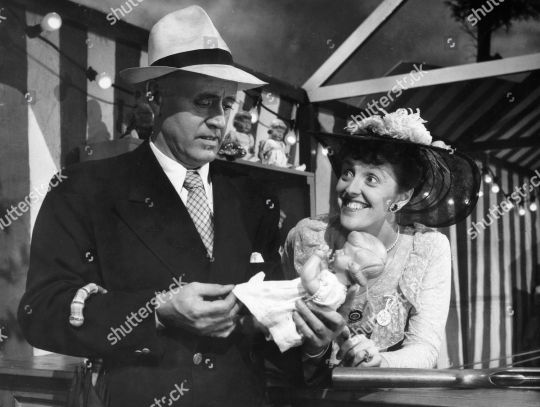

It's impossible to discuss Alfred Hitchcock’s STAGE FRIGHT (1950, TCM) without getting into the ending, so if you’ve never seen it or heard much about it and want to maintain your innocence on the subject STOP READING NOW.
And now the rest of you still reading can join me in laughing at the ones who stopped.
Just joking. But let’s get on with the discussion.
Acting student Eve Gill (Jane Wyman) has a crush on a man (Richard Todd) who tells her, in flashback, he’s been having an affair with an actress (Marlene Dietrich) who’s just murdered her husband. In attempting to cover up for her, Todd claims to have made himself the chief suspect, so Wyman hides him with her father’s (Alastair Sim) help and masquerades as Dietrich’s maid to try to get the goods on her.
Hitchcock always said his mistake in STAGE FRIGHT was opening the film with a flashback that lies. More recent critics (and those pesky French) have hailed the device as a witty subversion of genre expectations. I think it could indeed work that way in another movie. I think if one set up the characters properly, discovering the plucky young woman and her eccentric father had gone to a great deal of bother to protect a guilty man would make for a solid post-modern detective thriller. But here the characters aren’t set up at all before the flashback starts. The film opens on Wyman driving Todd to get away from the police as he tells her his story (which includes seeing Wyman in an acting class at RADA doing a scene from high comedy, and that may be a bigger crime than the story’s murder). It all feels too abrupt, and it seems to take forever to get to know the characters.
Of course, in Wyman’s case there isn’t much of a character to get to know. Hitchcock wanted a star, and he was working at Warner Bros., and she was their top female star at the time. But though she had done good work in lots of other films. she’s all wrong for the role. Eve has to be implusive and energetic and, above all, innocent. When she realizes she’s falling in love with the detective (Michael Wilding) on the case, she needs to be winsome and vulnerable. The younger Wyman could have played that, but after years of fighting to get anywhere at Warner Bros. she’s about as winsome as a Mac truck. It’s like watching Norma Shearer trying vainly to become Elizabeth Barrett Browning or Juliet. The business has kicked all the necessary elements of those characters right out of her. The film drags whenever she’s on screen, which is a lot. Wilding is charming in their love scenes, but he might as well be playing to a brick wall. Fortunately, there are some wonderful British character actors on the periphery: Sim, Sybil Thorndike, Miles Malleson, Kay Walsh and Joyce Grenfell as the lady with the lovely duckies.
And, of course, there’s Dietrich. The woman is a holy wonder, one of the screen’s supreme technicians. When Wyman doesn’t move her face for fear of betraying her age, she projects almost nothing. Dietrich’s face may be even more frozen, but she knows how to move her head, her eyes — it’s almost cellular. Watch the way she holds her feet performing Cole Porter’s “The Laziest Girl in Town,” and you’ll realize what an amazing artist she was. She knows how to write the script with her voice and her body. In the midst of a poorly constructed screenplay, she creates a compelling character who draws you in. When the film has to cut from her final closeup (which is almost breathtaking) to get to the rather clumsy denouement, it’s hard to care what happens to anybody else.
#alfred hitchcock#thrillers#jane wyman#marlene dietrich#richard todd#michael wilding#alastair sim#sylbil thorndike#miles malleson#kay walsh#joyce grenfell
1 note
·
View note
Text
The men of SUMMONING SYLVIA (2023) clockwise from top left-Troy Itawa, Michael J. Urie, Noah J. Ricketts and Sean Grandillo




0 notes
Text
Summoning Sylvia
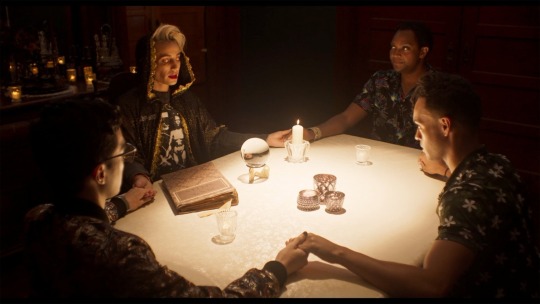

As a horror film, Wesley Taylor and Alex Wyse’s SUMMONING SYLVIA (2023, Shudder) would probably be considered something of a cheat by genre purists. As queer film, though it breaks no new ground and doesn’t go particularly deep as an exploration of gay lives, it has a utopian sweetness you may find hard to resist. And as comedy, it’s slick, with some actors whose timing is prettynear impeccable. Larry (Travis Coles) has been kidnapped by his best friends (Frankie Grande, Troy Iwata and Noah J. Ricketts) for a bachelor weekend in a remote, haunted house. That upsets Coles’ plans to get to know fiancé Michael J. Urie’s straight brother (Nicholas Logan), so Coles impulsively invites him to join the group. Only a) Logan is an uncommunicative military man who doesn’t know everyone there will be gay, and b) just before he arrives the friends hold a séance to summon the spirit of Sylvia (Veanne Cox), who was lynched for killing her son. Since this is horror comedy, and a queer one at that, expectations will be subverted. What starts as THE BOYS IN THE BAND becomes HOLD THAT GHOST. The gay men get into a little too much screaming when things start going wrong, but at least most it is well performed, particularly by Grande and, in a virtual cameo, Urie. I only wish they could have gotten the rights to Judy Garland’s recording of “After You’ve Gone,” which figures prominently in the action. Broadway star Carolee Carmello recorded an imitation that’s pitched uncomfortably between accurate and camp. It just needed to go further in one direction or the other.
#horror comedy#queer film#ghost stories#haunted house#michael j. urie#wesley taylor#alex wyse#veanne cox#frankie grande
1 note
·
View note
Text
Meet the People

Charles Reisner’s MEET THE PEOPLE (1944, TCM) was an important film for Dick Powell, if not for anyone else besides June Allyson. It’s the film on which they met (and if you see June’s number, “I Like to Recognize the Tune,” you’ll imagine Joan Blondell standing and cheering at the button), and it was his final turn as a boy singer before he changed his image in MURDER, MY SWEET (1944). He seems to be marking time here, which isn’t very fair to leading lady Lucille Ball, who pretty much has to carry their scenes. Like most of MGM’s lesser musicals, it has a negligible plot (playwriting welder Powell dares Broadway star Ball to get to know real people before he’ll let her star in his play) that ties together comic bits — some good, some unbearable — and musical numbers — ditto. There are too many minuses to list, so let’s concentrate on the positives. Ball is charming in a love scene when she talks about working her way up from the chorus. Bert Lahr has some funny bits and a cute song about sailing before he vanishes for no discernible reason. Also funny is Rags Ragland as a house husband saddled with two unbearable children (one of whom is Robert Blake). Allyson’s number may be one of Rodgers and Hart’s most forgettable songs, but it’s arranged wittily by Kay Thompson, who could do no wrong (and probably enjoyed the button, too). Spike Jones and his City Slickers have a funny routine with Cheetah from the Tarzan films playing Hitler and a musical segue into the sextette from LUCIA DI LAMMERMOOR. And Virginia O’Brien gets to do “Say We’re Sweethearts Again,” the greatest tribute to masochism until Tom Lehrer came along. Frankly, they should have jettisoned the plot and just done 90 minutes of Jones and O’Brien.
#movie musicals#dick powell#lucille ball#june allyson#kay thompson#virginia o'brien#spike jones#bert lahr#rags ragland#robert blake
0 notes
Text
Saint Maud
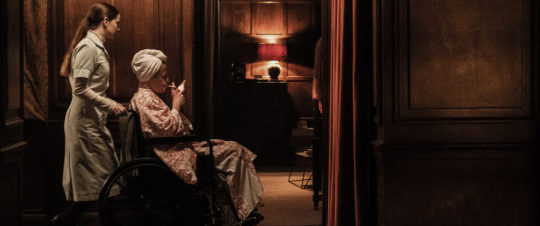
It would be easy to say that Rose Glass tilts SAINT MAUD (2019, Prime) against faith, but in truth the film isn’t about all religion but rather the misguided faith of its title character. After an unspecified error that costs her her nursing job at a local hospital, Maud (Morfydd Clark) immerses herself so thoroughly in the most extreme form of Catholicism that she prays kneeling on unpopped corn. She moves into private care and is assigned her opposite. Amanda (Jennifer Ehle) is a dancer and choreographer slowly dying of cancer. She’s also a total hedonist. Maud decides it’s her calling to convert Amanda, who goes along with her faith practices for the simple pleasure of leading her on. When Amanda tips her hand, Maud lashes out, losing her job and experiencing a religious crisis. Glass films this all straight on. Her style is almost dispassionate, even when she’s objectifying Maud’s weirdest fantasies. That and Clark’s performance pull you into Maud’s situation, even though you don’t have all the facts about her fall into grace. Clark is very good and quietly controlled. By contrast, Ehle sparkles with genius. She captures the frustrations of a woman who’s lived in her body but can no longer control it and makes it clear why she indulges Maud’s religious behavior. That doesn’t completely tilt the film toward the carnal. We see how Amanda pays for her excesses physically. Her life didn’t cause the cancer, but the cancer makes it hard for her to continue living as she used to. The film is, however, aligned against Maud’s excessive religiosity, a position made clear by the shocking final shot.
0 notes
Text
Shockproof

The combination of two filmmakers as distinctive as Samuel Fuller and Douglas Sirk would have made for a much better film than SHOCKPROOF (1949, TCM, YouTube) had Columbia Pictures not softened most of the rough edges of Fuller’s script. He wrote about a parole officer (Cornel Wilde) who becomes obsessed with a murderess (Patricia Knight, aka Mrs. Wilde) under his supervision. He tries to keep her from the gambler boyfriend (John Baragrey) for whom she had killed, gets her a job caring for his blind mother (Esther Minciotti) and, when she shoots a man to protect him, goes on the lam with her., The film still has a strong sense of the forces that drive Wilde from the straight and narrow and a wonderful bit of irony at the end that I can’t reveal. But it also has a hokey ending forced on Sirk and Fuller by the studio. Sirk hated it so much he left Columbia and briefly returned to Germany.
Sirk’s influence can be seen in an opening sequence that introduces Knight by following her picture hat as she adopts a new look and goes for her first check-in with Wilde (in one L.A.’s best. locations, The Bradbury Building). He also makes Wilde’s family home another character in the film (as he did with the family homes in ALL I DESIRE, ALL THAT HEAVEN ALLOWS, THERE’S ALWAYS TOMORROW and WRITTEN ON THE WIND). He tends to favor the story’s women, getting strong performances from Knight (she gives good regret), Minciotti, Ann Shoemaker as a police psychiatrist and Claire Clarkson as Knight and Wilde’s neighbor.
7 notes
·
View notes
Text
Terror in the Wax Museum
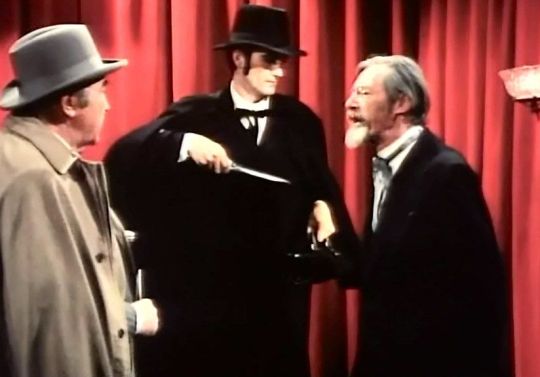
That Georg Fenady’s TERROR IN THE WAX MUSEUM (1973, Tubi, Prime, YouTube) looks like a TV movie, and a not very good one at that, shouldn’t be surprising. It’s one of only two theatrical features Fenady directed in a career mostly dedicated to television and was made for a low, even then, budget of $500,000. John Carradine, the proprietor of a chamber of horrors, is considering selling his collection when somebody murders him. With no will in sight, the estate is claimed by niece Nicole Shelby’s guardian (Elsa Lanchester), but someone or something is trying to drive them out. That sounds like the plot of a ‘40s B movie, and with its array of one-time stars (Ray Milland, Broderick Crawford, Maurice Evans, Louis Hayward, Patric Knowles) it looks like one, only not as well made. There are two decent shots in the whole film, and the revelation of the killer is so botched, you can only figure out whodunnit by process of elimination. Hayward comes closest to delivering a performance as a rather likable saloon owner, and Lanchester is very funny. What she can do with a word like “gargle” is a lesson in how to make bad dialog sound almost clever. Her line readings were the only thing that got me through this sorry mess. Milland has an embarrassingly bad drunk scene, especially considering that he won his Oscar for playing a drunk, but at least he has fun in a scene in which he conducts a tour through the museum. He can’t hold a candle for rottenness to Shelby, whose British accent keeps dropping whenever she encounters the word “sure.” There’s a sympathetic deaf-mute hunchback (Steven Marlo) treated with a surprising level of decency (despite his being stuck in a bad Halloween mask). Whenever people turn away while talking to him, they correct themselves and repeat the line to his face so he can read their lips. But then there’s a beautiful Chinese woman (Lucy Lu, who’s still acting in her 90s) repeatedly referred to as a “dragon lady.” Also in the cast is Shani Wallis, whose career obviously didn’t get much of a boost out of starring in OLIVER! (1968), as the finest music hall singer to walk the streets.
#horror films#bad movies#john carradine#elsa lanchester#ray milland#broderick crawford#marucie evans#louis hayward#patric knowles#shani wallis
0 notes
Text



The men of CRIME WAVE (1954) clockwise from top left-Sterling Hayden, Charles Bronson and Gene Evans
0 notes
Text
Crime Wave
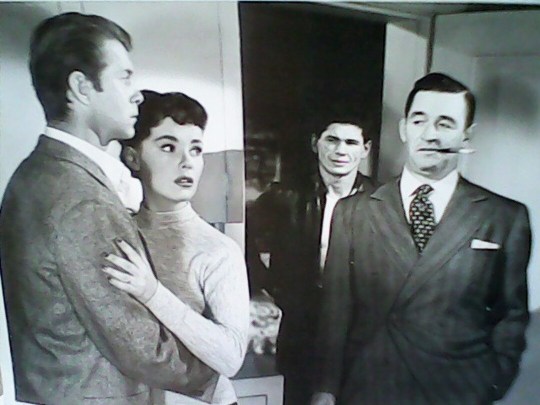

Andre de Toth’s CRIME WAVE (1954, TCM, YouTube) doesn’t look like any other Warner Bros. film of its period. A large part of that is a result of de Toth’s shooting almost entirely on location in Los Angeles, Burbank and Glendale and his use of non-professionals in small roles. That gives the film a documentary feel. But he also has a distinctive visual style, with striking compositions and telling details. At one point ex-con Gene Nelson has just gotten a middle-of the night phone call from a former jail mate who’s in trouble. Later police detective Sterling Hayden calls, and de Toth cuts to a close shot of the phone ringing. It’s notable that the light is still on, suggesting that Nelson and wife Phyllis Kirk haven’t been sleeping since the previous call. Nelson’s hand reaches into frame to pick up the phone, and Kirk grabs him. Only her hand is visible, but the wedding ring is prominent as she tells him not to let the call interrupt them.
It's a good thing de Toth has a strong visual sense and a good hand at directing actors, because the script isn’t all that exciting and promises more than it delivers. Three ex-cons (including Charles Buchinsky, later Bronson) who had done time with Nelson are engaged in a crime spree and need his help to pull off a bank job and escape to Mexico. Meanwhile, Hayden is pressuring Evans to keep him informed should he hear from them, even if it puts Evans and his wife in danger. It’s all pretty much by the numbers, but it moves fast and looks great. The cast is very good, and Evans and Bronson wear tight shirts, which adds a definite visual appeal (those into women aren’t as well served; Kirk is attractive but rather modest). The cast also features Ted Corsia as the criminal boss, Ned Young (who would later co-write THE DEFIANT ONES) as a wounded crook, Jay Novello as a doctor-turned-compassionate vet, Dub Taylor as a talkative gas station attendant, Iris Adrian and a lot of mascara as Bronson’s ex-, Timothy Carey as a demented crook who can steal scenes even when out of focus and the voice of Evans’ frequent co-star Doris Day on the radio at the start.
#film noir#andre de toth#gene evans#sterling hayden#phyllis kirk#charles bronson#doris day#iris adrian
1 note
·
View note
Text
The Shining



I had an interesting experience re-watching THE SHINING (1980, Showtime) for the first time in over 40 years. Going in I knew what had bothered me on my first viewing, so I was able to look past those things and appreciate a lot of the good things in the tale of a writer who takes a job at a hotel in the Rockies that’s shut down for the winter, Under the influence of the spirits there (it’s not in his head; all three members of the family see them), he becomes a threat to his wife and son. It’s hard to deny the visual and aural power of Kubrick’s work. The use of Steadicam and the scoring with contemporary composers like Bela Bartok and Gyorgi Ligeii help greatly in building a sense of dread. And though there have been complaints about the film’s slow pacing (the bathroom scene between Jack and Grady, the former caretaker now manifesting as a waiter, is particularly glacial), when Kubrick cuts quickly, it’s quite effective.
The biggest surprise for me, however, was Shelley Duvall. Despite pans from many critics and Stephen King, I think the performance works. She’s not just a helpless female there to scream a lot. She reads as a young wife emotionally closer to her son than her husband and trying desperately to make a failing marriage to an abusive dry drunk work. There’s also one very telling shot in which she’s tending the boilers at the hotel. This is supposed to be her husband’s job, but he’s become so consumed with writer’s block and the start of his possession, she’s had to step in and take over. And when their son returns from Room 237 with bruises and a torn sweater (one of the scariest things in the film is imaging what happened to him rather than seeing it), she not only assumes her husband has attacked him; she goes on the offensive in a surprisingly fierce moment.
My main sticking point with the film remains Jack Nicholson’s performance. King had complained that casting him on the heels of ONE FLEW OVER THE CUCKOO’S NEST (1975) would prepare audiences to see his character as insane. I had hoped that after years of seeing him play a variety of roles that sense of typecasting would have faded. But the problem isn’t that. It’s the choices he and Kubrick have made. In his first scene, the interview for the caretaker’s job, he’s under control. When he’s driving his family to the hotel there’s a telling moment that sums up the bad marriage. Duvall tries to start a conversion, and he dismisses her with an “mm-hmm.” But then he tells their child about the Donner Party and starts going manic. Even in the ‘70s, Nicholson was capable of subtle, controlled performances, but here over-the-top is his base. The funny moments when he wields his axe and yells “Honey, I’m home” and “Here’s Johnny” take over the horror for a moment. It’s just manic Jack having fun. Instead, I’d prefer to focus on the good performances from Duvall, Danny Lloyd as their psychic son, Barry Nelson as the hotel’s manager and Anne Jackson in one scene as the son’s pediatrician.
2 notes
·
View notes